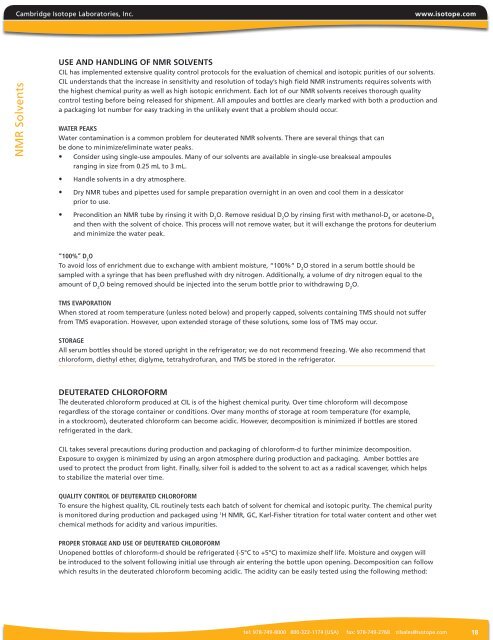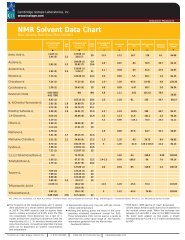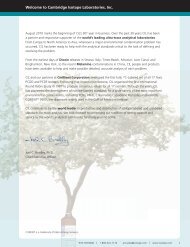Deuterated Solvents for NMR - Cambridge Isotope Laboratories
Deuterated Solvents for NMR - Cambridge Isotope Laboratories
Deuterated Solvents for NMR - Cambridge Isotope Laboratories
You also want an ePaper? Increase the reach of your titles
YUMPU automatically turns print PDFs into web optimized ePapers that Google loves.
<strong>Cambridge</strong> <strong>Isotope</strong> <strong>Laboratories</strong>, Inc. www.isotope.com<br />
<strong>NMR</strong> <strong>Solvents</strong><br />
USE AND hANDLING OF <strong>NMR</strong> SOLVENTS<br />
CIL has implemented extensive quality control protocols <strong>for</strong> the evaluation of chemical and isotopic purities of our solvents.<br />
CIL understands that the increase in sensitivity and resolution of today’s high field <strong>NMR</strong> instruments requires solvents with<br />
the highest chemical purity as well as high isotopic enrichment. Each lot of our <strong>NMR</strong> solvents receives thorough quality<br />
control testing be<strong>for</strong>e being released <strong>for</strong> shipment. All ampoules and bottles are clearly marked with both a production and<br />
a packaging lot number <strong>for</strong> easy tracking in the unlikely event that a problem should occur.<br />
Water PeakS<br />
Water contamination is a common problem <strong>for</strong> deuterated <strong>NMR</strong> solvents. There are several things that can<br />
be done to minimize/eliminate water peaks.<br />
• Consider using single-use ampoules. Many of our solvents are available in single-use breakseal ampoules<br />
ranging in size from 0.25 mL to 3 mL.<br />
• Handle solvents in a dry atmosphere.<br />
• Dry <strong>NMR</strong> tubes and pipettes used <strong>for</strong> sample preparation overnight in an oven and cool them in a dessicator<br />
prior to use.<br />
• Precondition an <strong>NMR</strong> tube by rinsing it with D 2 O. Remove residual D 2 O by rinsing first with methanol-D 4 or acetone-D 6<br />
and then with the solvent of choice. This process will not remove water, but it will exchange the protons <strong>for</strong> deuterium<br />
and minimize the water peak.<br />
“100%” d 2 o<br />
To avoid loss of enrichment due to exchange with ambient moisture, “100%” D 2 O stored in a serum bottle should be<br />
sampled with a syringe that has been preflushed with dry nitrogen. Additionally, a volume of dry nitrogen equal to the<br />
amount of D 2 O being removed should be injected into the serum bottle prior to withdrawing D 2 O.<br />
tmS evaPoratIon<br />
When stored at room temperature (unless noted below) and properly capped, solvents containing TMS should not suffer<br />
from TMS evaporation. However, upon extended storage of these solutions, some loss of TMS may occur.<br />
Storage<br />
All serum bottles should be stored upright in the refrigerator; we do not recommend freezing. We also recommend that<br />
chloro<strong>for</strong>m, diethyl ether, diglyme, tetrahydrofuran, and TMS be stored in the refrigerator.<br />
DEUTERATED ChLOROFORM<br />
The deuterated chloro<strong>for</strong>m produced at CIL is of the highest chemical purity. over time chloro<strong>for</strong>m will decompose<br />
regardless of the storage container or conditions. over many months of storage at room temperature (<strong>for</strong> example,<br />
in a stockroom), deuterated chloro<strong>for</strong>m can become acidic. However, decomposition is minimized if bottles are stored<br />
refrigerated in the dark.<br />
CIL takes several precautions during production and packaging of chloro<strong>for</strong>m-d to further minimize decomposition.<br />
Exposure to oxygen is minimized by using an argon atmosphere during production and packaging. Amber bottles are<br />
used to protect the product from light. Finally, silver foil is added to the solvent to act as a radical scavenger, which helps<br />
to stabilize the material over time.<br />
QuaLIty ControL oF deuterated ChLoroForm<br />
To ensure the highest quality, CIL routinely tests each batch of solvent <strong>for</strong> chemical and isotopic purity. The chemical purity<br />
is monitored during production and packaged using 1 H <strong>NMR</strong>, GC, Karl-Fisher titration <strong>for</strong> total water content and other wet<br />
chemical methods <strong>for</strong> acidity and various impurities.<br />
ProPer Storage and uSe oF deuterated ChLoroForm<br />
Unopened bottles of chloro<strong>for</strong>m-d should be refrigerated (-5°C to +5°C) to maximize shelf life. Moisture and oxygen will<br />
be introduced to the solvent following initial use through air entering the bottle upon opening. Decomposition can follow<br />
which results in the deuterated chloro<strong>for</strong>m becoming acidic. The acidity can be easily tested using the following method:<br />
unit<br />
tel: 978-749-8000 800-322-1174 (USA) fax: 978-749-2768 cilsales@isotope.com<br />
18







